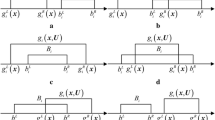Abstract
In this work, we further develop a newly proposed interval algebraic approach for analysis or design of structures involving uncertain interval-valued parameters. The methodology is based on an algebraic extension of classical interval arithmetic, namely Kaucher arithmetic, and within it the interval equilibrium equations can be completely satisfied by the primary unknown variables (displacements). Here this method is expanded to derived (secondary) variables—forces, strains and stresses which are of particular practical interest in design and strength of materials. Numerical examples are presented to illustrate the proposed methodology and to compare the algebraic interval approach to that based on classical interval arithmetic.





Similar content being viewed by others
References
Alefeld, G., Herzberger, J.: Introduction to Interval Computations. Academic Press, New York (1983)
Ben-Haim, Y., Elishakoff, I.: Convex Models of Uncertainty in Applied Mechanics. Elsevier, Amsterdam (1990)
Du, J., Du, Z., Wei, Y., Zhang, W., Guo, X.: Exact response bound analysis of truss structures via linear mixed 0–1 programming and sensitivity bounding technique. Int. J. Numer. Methods Eng. 116, 21–42 (2018)
Elishakoff, I.: Convex modeling—a generalization of interval analysis for non-probabilistic treatment of uncertainty. In: Proceedings of the International Workshop on Applications of Interval Computations (APIC’95), pp. 76–79 (1995)
Elishakoff, I., Gabriele, S., Wang, Y.: Generalized Galileo Galilei problem in interval setting for functionally related loads. Arch. Appl. Mech. 86(7), 1203–1217 (2016)
Elishakoff, I., Ohsaki, M.: Optimization and Anti-optimization of Structures Under Uncertainty. World Scientific, Singapore (2010)
Fuchs, M.B.: Unimodal formulation of the analysis and design problems for framed structures. Comput. Struct. 63, 739–747 (1997)
Ioakimidis, N.I.: Computation of ranges of functions in problems of applied mechanics with the computational method of quantifier elimination, TR-2018-Q3, Nemertes: institutional repository of the University of Patras. http://nemertes.lis.upatras.gr/jspui/bitstream/10889/11605/1/TR-2018-Q3.pdf. Accessed Jan 2019 (2018)
Kaucher, E.: Interval analysis in the extended interval space IR. Comput. Suppl. 2, 33–49 (1980)
Markov, S.M.: On directed interval arithmetic and its applications. J. Universal Comput. Sci. 1(7), 514–526 (1995)
Moens, D., Hanss, M.: Non-probabilistic finite element analysis for parametric uncertainty treatment in applied mechanics: recent advances. Finite Elem. Anal. Des. 47, 4–16 (2011)
Moore, R.E.: Interval Analysis. Prentice-Hall, Englewood Cliffs (1966)
Moore, R.E., Kearfott, R.B., Cloud, M.J.: Introduction to Interval Analysis. SIAM Press, Philadelphia (2009)
Muhanna, R.L.: Benchmarks for interval finite element computations, Center for Reliable Engineering Computing, Georgia Tech, USA. http://rec.ce.gatech.edu/resources/Benchmark_2.pdf. Accessed 12 Nov 2018 (2004)
Muscolino, G., Sofi, A.: Stochastic analysis of structures with uncertain-but-bounded parameters via improved interval analysis. Probab. Eng. Mech. 28, 152–163 (2012)
Popova, E.D.: The Arithmetic on Proper & Improper Intervals. http://www.math.bas.bg/~epopova/directed.html. Accessed 6 Dec 2018 (1996)
Popova, E.D.: Multiplication distributivity of proper and improper intervals. Reliab. Comput. 7(2), 129–140 (2001)
Popova, E.D.: Computer-assisted proofs in solving linear parametric problems. In: The Proceedings of SCAN’06, p. 35, IEEE Computer Society Press (2006)
Popova, E.D.: Improved solution to the generalized Galilei’s problem with interval loads. Arch. Appl. Mech. 87(1), 115–127 (2017)
Popova, E.D.: Equilibrium equations in interval models of structures. Int. J. Reliab. Saf. 12(1/2), 218–235 (2018)
Popova, E.D.: New parameterized solution with application to bounding secondary variables in FE models of structures. arXiv:1812.07300 (2018)
Popova, E.D.: Algebraic solution to interval equilibrium equations of truss structures. Appl. Math. Model. 65, 489–506 (2019)
Qiu, Z., Elishakoff, I.: Antioptimization of structures with large uncertain-but-non-random parameters via interval analysis. Comput. Methods Appl. Mech. Eng. 152, 361–372 (1998)
Qiu, Z.P., Wang, L.: The need for introduction of non-probabilistic interval conceptions into structural analysis and design. Sci. China Phys. Mech. Astron. 59(11), 114632 (2016)
Rama Rao, M.V., Mullen, R.L., Muhanna, R.L.: A new interval finite element formulation with the same accuracy in primary and derived variables. Int. J. Reliab. Saf. 5, 336–357 (2011)
Sainz, M.A., Armengol, J., Calm, R., Herrero, P., Jorba, L., Vehi, J.: Modal Interval Analysis: New Tools for Numerical Information. Lecture Notes in Mathematics 2091, Springer (2014)
Sofi, A., Romeo, E.: A novel interval finite element method based on the improved interval analysis. Comput. Methods Appl. Mech. Eng. 311, 671–697 (2016)
Sofi, A., Romeo, E., Barrera, O., Cocks, A.: An interval finite element method for the analysis of structures with spatially varying uncertainties. Adv. Eng. Softw. 128, 1–19 (2019)
Su, J., Zhu, Y., Wang, J., Li, A., Yang, G.: An improved interval finite element method based on the element-by-element technique for large truss system and plane problems. Arch. Mech. Eng. 10(4), 1–10 (2018)
Verhaeghe, W., Desmet, W., Vandepitte, D., Moens, D.: Interval fields to represent uncertainty on the output side of a static FE analysis. Comput. Methods Appl. Mech. Eng. 260, 50–62 (2013)
Wu, J., Luo, Z., Zhang, Y., Zhang, N., Chen, L.: Interval uncertain method for multibody mechanical systems using Chebyshev inclusion functions. Int. J. Numer. Methods Eng. 95, 608–630 (2013)
Acknowledgements
The first author is supported by the National Scientific Program “Information and Communication Technologies for a Single Digital Market in Science, Education and Security (ICTinSES)”, financed by the Bulgarian Ministry of Education and Science.
Author information
Authors and Affiliations
Corresponding author
Additional information
Publisher's Note
Springer Nature remains neutral with regard to jurisdictional claims in published maps and institutional affiliations.
Rights and permissions
About this article
Cite this article
Popova, E.D., Elishakoff, I. Novel interval model applied to derived variables in static and structural problems. Arch Appl Mech 90, 869–881 (2020). https://doi.org/10.1007/s00419-019-01644-8
Received:
Accepted:
Published:
Issue Date:
DOI: https://doi.org/10.1007/s00419-019-01644-8




